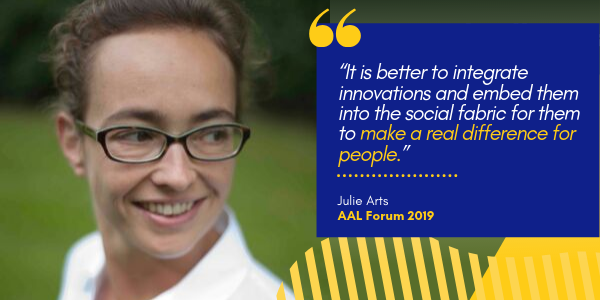Julie Arts: An ecosystem approach
AAL is developing a proposal for a future European partnership programme that introduces an ecosystem approach for ageing well. But what does that approach actually mean? Julie Arts works for the renowned Presencing Institute, providing action research for societal transformation and she will provide valuable insight into this approach during her keynote address and a workshop on Tuesday morning.
Can you explain what an ecosystem approach is?
An ecosystem is an interconnected collaboration within an ecosystem itself, which could be geographic or sector wide, for example. It’s a community of organisms – individuals, institutions, organisations – who start to work with each other and interact with each other in order to evolve and adapt to external influences. In an ecosystem approach you need to look at how everything is connected, what are the interdependencies within this system – and you focus on all the players involved, not just stakeholders, and understand their relationships and dynamics.
And in looking at it like this, you don’t only look at what you can perceive right now, but what the root causes are of some of those dynamics and relationships. That gives you a real understanding of how things currently operate and relate to each other and it is from this deeper understanding that you can find interventions that have a more sustainable impact instead of just being reactions to symptoms.
If we want to change something disruptively or sustainably we have to go to the underlying assumptions and question what they give rise to. You can confirm those assumptions or shift them – and this is a step that is often overlooked in this age of speedy life and work and in the case of many organisations like AAL, in the complexity of being a European network with almost every aspect of societal life is involved. To see clearly through such complexity, it is good to ask why and question those mental models. Another typical thing about an ecosystem approach is that although it is about creating results and innovations, what you are working towards is an aspiration and a lot of that aspiration is accepting that we don’t really know what it will look like in the end. That means creating or embracing a village of interventions and innovations instead of working towards building that one solution that will fix it all once we implement it. By the time everyone has agreed on that one solution it would probably have been watered down and the times will have changed. So, what you do is create in your ecosystem spaces for innovation and learning where a multitude of innovations can arise – and you learn from that and constantly adapt to what you are learning. So, you are not looking for that one solution that you can develop and implement, standardise and upscale.
A lot in an ecosystem works regionally or locally in different parts of the system and it’s when you take time to connect those and learn from them that you see what is taking shape. That is a very different approach because you have to accept that you can only see clearly what you know now and you need to allow for innovation to happen in different places.
How will this all apply to AAL?
I see a shift in thinking happening in the case of many organisations like AAL that have the capacity to convene many different stakeholders. The role that these organisations could have in an ecosystem approach is to create the conditions for collaboration, innovation and learning – which is a different approach to what often happens, which is to try to figure it all out and then coordinate everyone to do what they think is best.
The ecosystem approach will be more about AAL convening and creating the conditions, allowing the connections to arise, leading to more self-organised innovation than coordinated innovation. Another role that AAL can adopt is to allow innovation to happen locally and regionally and then provide the communication as a whole so that others can learn. AAL can create the infrastructure for the learning to be seen and to be shared – support locally and then connect globally. People will need to let go of the yearning to see things that work in one area simply copied to work in their area. We need to look at things in the context of our own spaces and then reproduce it, which is a very different thing to copying it. You have to adapt things to the local circumstance. It’s a case of discerning what is universal and will apply to me too and what needs to be adapted to the local context – a skill in itself.
How does this shift take place?
AAL is very articulate in expressing what they have done so far, what they have achieved, but that times are changing and that they believe in a new approach. The capacity to articulate and share this information is very important, but AAL now needs to see who is attracted to this approach, who is on board. With an ecosystem approach, you cannot push something top down. You need to attract and pull the right players in and that is when the relationships and the connections start to work. Communication is key to all this, certainly now in the first stages.
It’s then a question about having the right conversations – what’s already there and what are the aspirations – and it will be for AAL to create the right conditions for these conversations to take place. It will take time to get this in place and for things to become aligned that lead to co-creation. Sometimes you see networks that get stuck in the talking and others that get stuck in the doing without the talking. A subtle balance of autonomy and connectedness is needed.
Why would AAL adopt this?
There is an understanding in all the sectors I work in, and I notice it in this one as well, that a lot of the solutions are actually available and somehow there is not that systemic shift. This could be that we have focused on the technical solutions and not on the social adaption process and how the solutions contribute to the overall aim – which in AAL’s case is ageing well. Focusing on the solutions means they are rarely adopted as they are not connected to all the stakeholders – their situations and needs, to the people. If we don’t look at the social complexity we end up with a lot of good solutions that are pushed into the system and they constantly keep changing. If you just focus on innovation, you can innovate forever and by the time it gets adopted, there is already another one available. It is better to integrate innovations and embed them into the social fabric for them to make a real difference for people. A human connection will lead to social adoption.
How should AAL adopt this approach?
If we look at AAL and what has been achieved so far and then consider what is needed now, I cannot give that answer right now. The whole point now is to raise curiosity, bring people together and provide the context for them to figure out the answer. After my keynote speech, we have a workshop on this, but that is just the beginning of a journey of finding a way forward. Someone coming in from the outside and saying ‘I think it should look like this’ is the old model.
What is key is that the stakeholders are brought together at the forum and a dialogue is started – if this is an approach that we believe is necessary for the whole and would benefit not only older people but all the organisations involved in AAL, then how are we going to get there? It starts with listening a lot – AAL is good at that and they understand the current system. But they also need to look at the world around them and the context in which they operate – these are the disruptions and the challenges we now see.
AAL wants to ‘support regional ecosystems to stimulate innovation, exchange and large-scale adoption’. It’s very hard to disagree that such an approach is very important given where we are right now. AAL needs to provide anchors about what it could look like and then nurture dialogue to co-create what it could become. What I have learned is that the moment you say ‘this is the answer’ it all stops working because it’s not co-creative, it’s not enquired into. In an ecosystem, where there is no formal authority, co-creative and participatory processes become hugely important.
The AAL’s reasoning is connected to the world of today and related to where it is right now and it has created something that will speak to all stakeholders. If it does, they will then have the opportunity to step into the conversation knowing they have an idea of what is possible.

